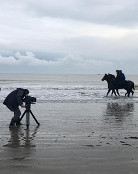Donn's Articles » Second strings
Second strings
There was a fair degree of head-scratching when Mastery beat Kite Wood in last year’s Ladbrokes St Leger, Godolphin’s second string, Frankie Dettori’s reject, a 14/1 shot beating the stable’s selected, the 9/4 favourite.
Jockey Ted Durcan wasn’t one of those who doffed his white cap and scratched his head however. On the contrary, he was delighted to get the call up to ride Mastery, and he quite fancied his chances. His horse had stayed on well to finish second in the Great Voltigeur, and the rider knew that he was in great form and that he would stay the trip. Also, crucially, he knew that the son of Sulamani would bounce off the fast ground. “You’re not just a second string here,” trainer Saeed Bin Suroor told him on the morning of the race. The punters couldn’t really see it.
That’s the thing about second strings, they are often ignored by punters and allowed go off at a bigger price than their form should dictate. These things are easy in hindsight, and Kite Wood was obviously the stable’s number one in last year’s St Leger, but the discrepancy in odds between the two Godolphin horses that day was probably too great. It probably wasn’t a fair reflection of their respective chances of winning the race. It is often the way, the stable jockey makes his decision and the market reacts: the trainer knows, the stable jockey knows. The reality is, however, that they don’t know for sure.
You can’t know for sure. You can’t replicate racing conditions at home on the gallops, and even if you could, you wouldn’t want to. You prepare for the race at home, you don’t run it there. Dr Vincent O’Brien used to famously despair betimes when Lester would ride work at Ballydoyle, simply because the two racing legends’ respective objectives from a piece of work could differ significantly: bring the horse along, slowly slowly, save the energy-burst for the race, versus find out how good the horse is on the gallops before you have to decide whether or not to ride him in the race.
It was interesting to listen to Seamus Heffernan speak after he won the Group 1 Moyglare Stud Stakes 10 days ago on Misty For Me – joint second highest in the market of four Aidan O’Brien-trained fillies in the race – of how they thought beforehand that Johnny Murtagh’s mount Together was the best of their four, based on their home work. However, Misty For Me was officially rated 3lb superior to Together going into the race, and she had raced just three times beforehand while Together had raced four times, so possibly had more scope for progression. Yet, because Johnny Murtagh chose to ride Together, she was sent off a 4/1 shot while Misty For Me was allowed go off at 10/1. Hindsight: 20-20.
It was a similar story in the Tattersalls Millions Irish Champion Stakes on Saturday. Rip Van Winkle was all the rage all week, an odds-on shot, the Ballydoyle flag-bearer, but the market didn’t adjust when the rains came on Saturday morning. Every drop that fell amplified the stamina requirement, by implication increasing the chances of Irish Derby winner Cape Blanco while at the same time decreasing the chances of dual Group 1 winning miler Rip Van Winkle, and helping Seamus Heffernan claim his second Group 1 win in six days. Actually, of Aidan O’Brien’s four winners at Leopardstown on Saturday, Johnny Murtagh rode just two. They don’t always know.
Of course, the phenomenon of second strings upsetting the stable’s selected and the punters is not a new one. Michael Kinane dined out during his formative years on the international stage under a white cap. He famously got the Sheikh Mohammed-owned, Henry Cecil-trained Belmez up to beat Steve Cauthen on his better-fancied stable companion Old Vic by a neck in the 1990 King George VI and Queen Elizabeth Diamond Stakes, and he wore another white cap when he rode Commander In Chief to victory in the 1993 Derby as Prince Khalid Abdullah’s other representative, the odds-on favourite Tenby, floundered on the cambers under Pat Eddery.
Godolphin’s white cap is a frequent gate-crasher at the top level. The 33/1 shock that supposed pacemaker Summoner sprang in the 2001 Queen Elizabeth II Stakes, getting home by a length and a half from his stable companion Noverre, should have meant that second strings would never be ignored again.
Fly To The Stars’s Lockinge Stakes win in 1999, Cape Cross’s 1998 Lockinge Stakes, Cape Cross’s 1999 Queen Anne, Cape Cross’s 1999 Celebration Mile – all achieved under the white cap. Indeed, so prominent was the white cap in Cape Cross’s racing career that, when he embarked on his new and ultimately phenomenally successful career at stud, the promotional baseball caps were white, not the traditional Godolphin blue.
The white cap may not be a badge of inferiority, it may be simply a mark of value.
© The Racing Post, 7th September 2010


 Follow Donn
Follow Donn